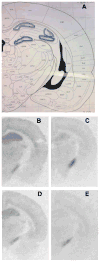Sex-specific alterations in hippocampal cannabinoid 1 receptor expression following adolescent delta-9-tetrahydrocannabinol treatment in the rat
- PMID: 26118897
- PMCID: PMC4551506
- DOI: 10.1016/j.neulet.2015.06.033
Sex-specific alterations in hippocampal cannabinoid 1 receptor expression following adolescent delta-9-tetrahydrocannabinol treatment in the rat
Abstract
Marijuana use by adolescents has been on the rise since the early 1990s. With recent legalization and decriminalization acts passed, cannabinoid exposure in adolescents will undoubtedly increase. Human studies are limited in their ability to examine underlying changes in brain biochemistry making rodent models valuable. Studies in adult and adolescent animals show region and sex specific downregulation of the cannabinoid 1 (CB1) receptor following chronic cannabinoid treatment. However, although sex-dependent changes in behavior have been observed during the drug abstinence period following adolescent cannabinoid exposure, little is known about CB1 receptor expression during this critical time. In order to characterize CB1 receptor expression following chronic adolescent Δ-9-tetrahydrocannabinol (THC) exposure, we used [(3)H] CP55,940 binding to assess CB1 receptor expression in the dentate gyrus and areas CA1, CA2, and CA3 of the hippocampus in both male and female adolescent rats at both 24h and 2 weeks post chronic THC treatment. Consistent with other reported findings, we found downregulation of the CB1 receptor in the hippocampal formation at 24h post treatment. While this downregulation persisted in both sexes following two weeks of abstinence in the CA2 region, in females, this downregulation also persisted in areas CA1 and CA3. Expression in the dentate gyrus returned to the normal range by two weeks. These data suggest that selective regions of the hippocampus show persistent reductions in CB1 receptor expression and that these reductions are more widespread in female compared to male adolescents.
Keywords: Adolescence; CB1 receptor expression; Delta-9-Tetrahydrocannabinol; Hippocampus; Sex differences.
Copyright © 2015 Elsevier Ireland Ltd. All rights reserved.
Figures



Similar articles
-
Sex, THC, and hormones: Effects on density and sensitivity of CB1 cannabinoid receptors in rats.Drug Alcohol Depend. 2019 Jan 1;194:20-27. doi: 10.1016/j.drugalcdep.2018.09.018. Epub 2018 Oct 25. Drug Alcohol Depend. 2019. PMID: 30391834 Free PMC article.
-
Effects of chronic exposure to delta9-tetrahydrocannabinol on cannabinoid receptor binding and mRNA levels in several rat brain regions.Brain Res Mol Brain Res. 1997 Jun;46(1-2):100-8. doi: 10.1016/s0169-328x(96)00277-x. Brain Res Mol Brain Res. 1997. PMID: 9191083
-
Hippocampal CB(1) receptors mediate the memory impairing effects of Delta(9)-tetrahydrocannabinol.Neuropsychopharmacology. 2009 Aug;34(9):2072-80. doi: 10.1038/npp.2009.31. Epub 2009 Mar 25. Neuropsychopharmacology. 2009. PMID: 19322169 Free PMC article.
-
Sex and age specific effects of delta-9-tetrahydrocannabinol during the periadolescent period in the rat: The unique susceptibility of the prepubescent animal.Neurotoxicol Teratol. 2016 Nov-Dec;58:88-100. doi: 10.1016/j.ntt.2016.02.005. Epub 2016 Feb 16. Neurotoxicol Teratol. 2016. PMID: 26898326 Review.
-
Sexually-dimorphic alterations in cannabinoid receptor density depend upon prenatal/early postnatal history.Neurotoxicol Teratol. 2016 Nov-Dec;58:31-39. doi: 10.1016/j.ntt.2016.09.004. Epub 2016 Sep 12. Neurotoxicol Teratol. 2016. PMID: 27634313 Free PMC article. Review.
Cited by
-
Cannabis in Adolescence: Lasting Cognitive Alterations and Underlying Mechanisms.Cannabis Cannabinoid Res. 2023 Feb;8(1):12-23. doi: 10.1089/can.2022.0183. Epub 2022 Oct 26. Cannabis Cannabinoid Res. 2023. PMID: 36301550 Free PMC article. Review.
-
Chronic Δ9-tetrahydrocannabinol treatment has dose-dependent effects on open field exploratory behavior and [3H] SR141716A receptor binding in the rat brain.Life Sci. 2023 Aug 15;327:121825. doi: 10.1016/j.lfs.2023.121825. Epub 2023 Jun 1. Life Sci. 2023. PMID: 37270168 Free PMC article.
-
Sex, species and age: Effects of rodent demographics on the pharmacology of ∆9-tetrahydrocanabinol.Prog Neuropsychopharmacol Biol Psychiatry. 2021 Mar 2;106:110064. doi: 10.1016/j.pnpbp.2020.110064. Epub 2020 Aug 15. Prog Neuropsychopharmacol Biol Psychiatry. 2021. PMID: 32810571 Free PMC article.
-
Mechanisms Underlying Sex Differences in Cannabis Use.Curr Addict Rep. 2017 Dec;4(4):439-453. doi: 10.1007/s40429-017-0174-7. Epub 2017 Oct 19. Curr Addict Rep. 2017. PMID: 29503790 Free PMC article.
-
Intravenous self-administration of delta-9-THC in adolescent rats produces long-lasting alterations in behavior and receptor protein expression.Psychopharmacology (Berl). 2021 Jan;238(1):305-319. doi: 10.1007/s00213-020-05684-9. Epub 2020 Oct 27. Psychopharmacology (Berl). 2021. PMID: 33111197 Free PMC article.
References
-
- United States. Substance Abuse and Mental Health Services Administration. Center for Behavioral Health Statistics and Quality. Treatment episode data set (TEDS) 1999–2009 : state admissions to substance abuse treatment services, Center for Behavioral Health Statistics and Quality. Substance Abuse and Mental Health Services Administration; Rockville, MD: 2011. p. xiv.p. 163.
-
- Ehrenreich H, Rinn T, Kunert HJ, Moeller MR, Poser W, Schilling L, Gigerenzer G, Hoehe MR. Specific attentional dysfunction in adults following early start of cannabis use. Psychopharmacology. 1999;142:295–301. - PubMed
-
- Hall W, Degenhardt L. Adverse health effects of non-medical cannabis use. Lancet. 2009;374:1383–1391. - PubMed
-
- Pope HG, Jr, Gruber AJ, Hudson JI, Cohane G, Huestis MA, Yurgelun-Todd D. Early-onset cannabis use and cognitive deficits: what is the nature of the association? Drug and alcohol dependence. 2003;69:303–310. - PubMed
-
- Rodriguez de Fonseca F, Ramos JA, Bonnin A, Fernandez-Ruiz JJ. Presence of cannabinoid binding sites in the brain from early postnatal ages. Neuroreport. 1993;4:135–138. - PubMed
Publication types
MeSH terms
Substances
Grants and funding
LinkOut - more resources
Full Text Sources
Other Literature Sources
Miscellaneous

